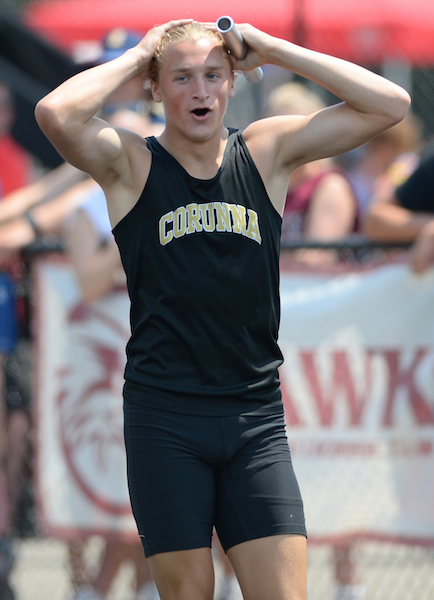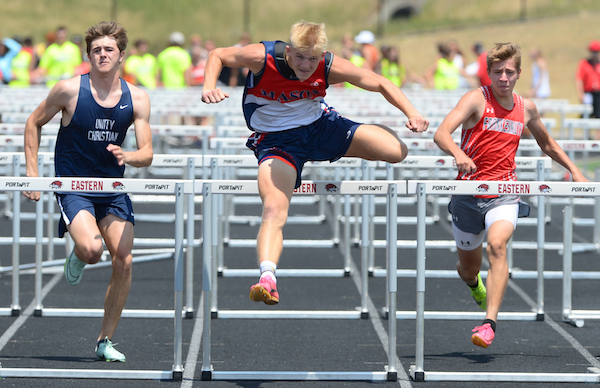
Many Contribute in Marquette Boys Repeat
By
John Vrancic
Special for MHSAA.com
June 5, 2016
KINGSFORD — The Houghton boys gave chase, but Marquette withstood the Gremlins’ challenge while retaining the Upper Peninsula Division 1 track and field title Saturday.
Marquette collected 144 points to repeat and win its fifth title in seven seasons. Houghton followed with 111 points, and Kingsford tallied 72.
“We had a lot of guys step up,” said Marquette coach Kyle Detmers. “I’m proud of their effort. Hats off to Houghton. They had a great meet. I think they’ll be the team to beat next year.”
Senior distance ace Lance Rambo provided the Redmen with victories in the 800-meter run at 1 minute, 59.23 seconds and 1,600 (4:25.26).
Then in the 3,200, Rambo was well ahead of the field on the last turn of the sixth lap (of eight) when he suddenly hopped off the track in a great deal of pain caused by plantar fasciitis.
“I’ve had it for about a week,” Rambo said. “It’s really not that bad, but I didn’t get to ice it down after the 800 and it got worse during the 3,200. I’m happy about my first two races and the fact our team did so well. I had decent times in the 800 and 1,600.”
Rambo’s misfortune opened the door for Escanaba junior Joey Wolfe, who won in a personal-best 9:59.78.
“Hats off to Joey,” said Rambo. “He ran a great race.”
Lance’s brother, Luke Rambo, was runner-up (10:05.29) and Sault Ste. Marie’s Aaron Kinsella took third (10:07.11) in a race where the Division 1 and 2 runners ran together.
“It was a tragedy and a blessing,” said Wolfe. “I saw Lance go off the track and didn’t know what to think. Nate (Carey of Iron Mountain) and the kid from the Sault were right next to me. I told myself, ‘this is my chance,’ and took off in the last lap. Anything can happen. That’s why you always try to do your best. Yet, I feel bad for Lance. I just hope it wasn’t anything too serious.”
 Marquette’s Pat Burmeister won the 100 (11.4), placed second in the 200 (23.36) and anchored the runner-up sprint relays.
Marquette’s Pat Burmeister won the 100 (11.4), placed second in the 200 (23.36) and anchored the runner-up sprint relays.
Teammate Brad Seaborg added a first in the 300 hurdles (42.32). Payton Muljo won shot put at 44 feet, ½ inch, and Taylor Althouse took high jump (5-10).
“Lance ran great races in the 800 and 1,600,” said Detmers. “Luke really helped us by taking second in the 3,200 when Lance went down. We scored about 40 points in the field events, which hasn’t been common for us. We were seeded fourth in long jump and we got second and fifth. The only disappointment we had is our 3,200 relay got disqualified.”
Houghton won the day’s opening race in 8:15.38, and Clayton Sayen captured the 400 (51.7), took second in the 800 (2:02.49) and third in the 1,600 (4:38.48). Brad Ohtonen added a first in discus (120-2).
Kingsford’s sprint relays, anchored by Ben Moreau, took first in the 400 (45.01) and 800 (1:34.1).
The Flivvers also got a first from Mike Jamar in long jump (20-1¼), with Marquette’s Wyatt Goodwin runner-up (20-½).
PHOTOS: (Top) Marquette and Houghton battle during the 3,200 relay, won by the eventual overall runner-up Gremlins. (Middle) Negaunee’s Joe Grasso (far left) celebrates his 110 hurdles championship. (Photos by Cara Kamps.)

Vicksburg's Wright, Corunna Right On in Claiming LPD2 Championships
By
Steve Vedder
Special for MHSAA.com
June 3, 2023
ADA – If Michael Wright was a baseball player, he probably would've been called out on strikes a year ago.
Instead, the Vicksburg senior can celebrate after winning the 200 at Saturday's Lower Peninsula Division 2 Track & Field Finals at Forest Hills Eastern.
The road to the championship in the 200, via a time of 21.72, was anything but a straight line for Wright. An aspiring baseball player, he was cut from the Vicksburg squad as a freshman. His football career, by Wright's own admission, was "on and off." And then a year ago in his first track meet, Wright suffered a leg injury that virtually ended his season. He did return to finish fifth in the 200 at Finals while helping the 400 relay team to a 16th place.
So there is nothing to realistically explain how Wright found himself in the position Saturday at sweltering Forest Hills Eastern to win a championship. Except for returning this season to break the school record in the 200 four times in two months. Well, that and willpower and simple desire.
 "I knew I could finish high, maybe in the top five. But this is better," said Wright, who credits drinking large quantities of milk for his resurgence. "I looked to football because I didn't think I could bounce back for track. But I overcame the bumps, the obstacles."
"I knew I could finish high, maybe in the top five. But this is better," said Wright, who credits drinking large quantities of milk for his resurgence. "I looked to football because I didn't think I could bounce back for track. But I overcame the bumps, the obstacles."
While Wright was jump-starting his track career, Corunna won the team title with 41 points. Mason and Forest Hills Eastern tied for second with 35. Whitehall was fourth with 33 points, and Frankenmuth fifth with 29 points.
Corunna coach Jeff Sawyer, who had never won a Finals title in 37 years coaching at Owosso and three more at Corunna, said the championship came after little fanfare during the season. Virtually right up until the time Corunna hauled off its first-place trophy, Sawyer said it was never really on his team's mind. The title came after the team managed only a runner-up finish at the Regional.
"We kind of low-keyed it," he said. "We knew scoring 40 points was possible. We lost to Frankenmuth by one point at the Regional. … We were a little disappointed we didn't win, but we had some good times today. We knew it was possible.
"Every day we just come and do what we do. We talk about getting better every day with PRs (personal records). And we're still getting better because we have some tough guys. Just competitive, tough kids. But we were the underdogs."
Corunna had only two firsts on Saturday, in the 400 relay (42.63) and Wyatt Bower in the long jump (22-8½).
Among the individual highlights was Frankenmuth senior Dalton DeBeau, who successfully defended his Finals title in the discus (171-6). He was fifth in that event as a sophomore and after winning a year ago, was considered a good bet to repeat.
"I kind of expected it," said DeBeau, who will compete at Michigan State next spring. "There wasn't a lot of pressure. I knew what had to be done. I threw 160 feet on my first throw to get in the finals, and that helped right away. I knew I could go all out."
 Berrien Springs' Jake Machiniak won the 100 (10.54) while the team also captured the 800 relay (1:28.18). Machiniak said his season hasn't been without its share of difficulties. There was a time when he couldn't seem to come out of the starting blocks smoothly. But beginning with the conference meet where he ran school record 10:73, Machiniak felt himself back on course.
Berrien Springs' Jake Machiniak won the 100 (10.54) while the team also captured the 800 relay (1:28.18). Machiniak said his season hasn't been without its share of difficulties. There was a time when he couldn't seem to come out of the starting blocks smoothly. But beginning with the conference meet where he ran school record 10:73, Machiniak felt himself back on course.
"There were ups and downs. I struggled in the middle of the season," he said. "But my teammates helped me through some difficulties. I came here to finish the job; I knew I could do something here."
Mason's Tyler Baker won the 100 hurdles (14.63) to complete a long journey that included finishing just ninth in last year's prelims. The success was as simple as putting in loads of offseason work.
"I practiced and did stuff about every day," he said. "I might not be the fastest, but I make up for that in form. It's a fine-tuning thing. Everyone wants to be faster."
Mason also got a championship from A.J. Mantel, who captured the 300 hurdles (38.90).
Among other highlights was Forest Hills Eastern senior Aiden Sullivan successfully defending a 2022 title on his own home turf. He won Saturday's 800 (1:53.92).
Adrian won the 3,200 relay (7:39.77), while Grand Rapids Christian took the 1,600 (3:24.49).
Alma had two individual winners in Michael Howey in the shot (55-08) and Jacob Dunlap in the high jump (6-7).
The other champs were Kyle Eberhard of Linden in the 1,600 (4:14.79), Whitehall's Trannon Ayler in the 400 (48.83), Freeland's T.J. Hansen in the 3,200 (9:11.56) and Sam Vesperman of Grosse Ile in the pole vault (15.01). Chelsea senior Jacob Nelson competed in the adaptive 100 (27.28), 200 (57.71) and shot put (6-6).
PHOTOS (Top) Vicksburg's Michael Wright celebrates after winning the 200 on Saturday. (Middle) Corunna's Tarick Bower enjoys a moment after anchoring the winning 400 relay. (Below) Mason's Tyler Baker, center, works to stay ahead in the 110 hurdles. (Photos by Dave McCauley/RunMichigan.com.)

